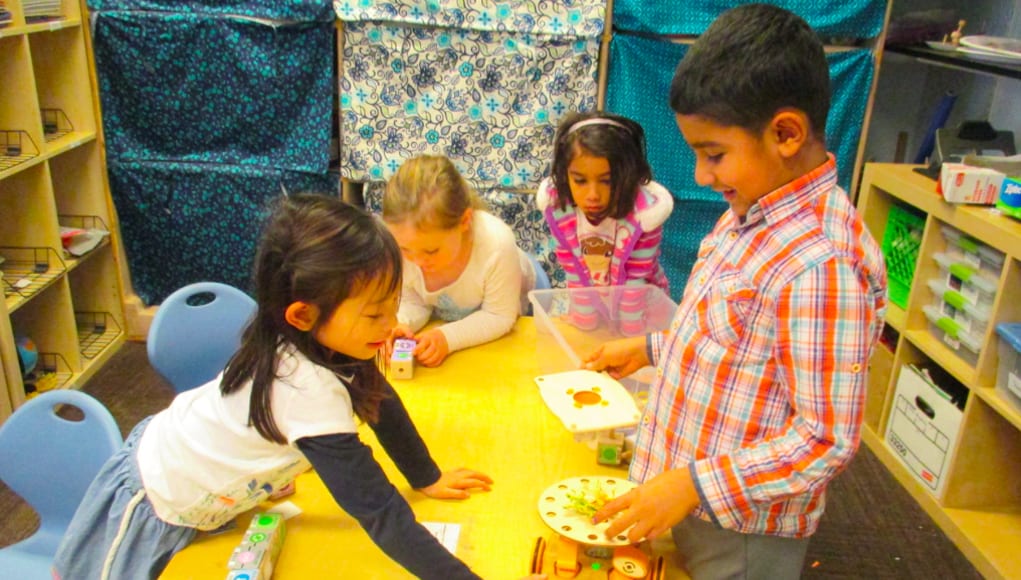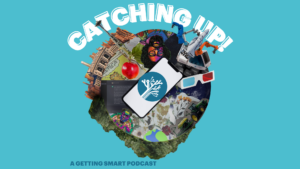Using Robots to Teach Elementary Students About Human Nature

By Hannah DeRusha
This past year, I asked my class of kindergarten and first-grade students at the Acera School of Science, Creativity and Leadership some big questions. Questions like “What does it mean to be human?” and “What makes a robot different from a human?”
Concepts like these may sound challenging for children as young as five-years-old, but by breaking down big ideas into bite-sized applications, we can introduce young learners to a new way of thinking. When I first bought a kit of customizable robots into my classroom, there were several learning areas that I hoped to engage:
- STEM instruction and critical thinking;
- Storytelling and creative thinking; and
- The philosophy behind robotics, to help my students better understand robots and the science and thought behind them.
To achieve this, we pursued hands-on engagement through open discussions, whimsical coding assignments and experimental play with a small toy robot named KIBO.
Starting With the End in Mind
The initial interaction with our robots and their programming blocks was purely experimental–a sort of trial-and-error approach. I explained the basic concepts to my students: each block represents a command; you can put blocks together to make a program; and once you scan the program with the robot, it will carry out your commands. Then I simply let them experiment to see what happened.
Once that foundation was laid, I helped my students understand the idea of reverse engineering. “Think of the end result you want first,” I told them. “And then try and figure out how to get there with the tools you have.” To help encourage this new way of thinking, I would sometimes project a basic program on the board and ask the children to act out what they thought the robot’s action would be. We would then compare their attempt to what the robot actually did. Often, they were surprised to see the actual result.
 The lesson really came down to helping them develop their logical thinking by considering their choice of commands and the order they came in. This was reinforced by seeing that the same commands, given in a different order, often had a different result in behavior.
The lesson really came down to helping them develop their logical thinking by considering their choice of commands and the order they came in. This was reinforced by seeing that the same commands, given in a different order, often had a different result in behavior.
This opened the door for critical thinking for students, inspiring them to think about the end result of the “if/then” statements they were creating. Their learning was almost subconscious, allowing them to focus on the fun of solving the problem at hand while developing crucial early development skills.
Robot Storytelling
Now that I had my students thinking critically about programming and the results of their actions, I wanted to broaden their understanding of robotics from the practical to the creative. We started with a story assignment in which the children had to design their robot as the main character of a story they brainstormed and wrote.
Students had to program their robot to act out the actions of the plot and think creatively about how to effectively convey certain ideas. For example, if there was a point in their story when the sun came up, they could program their robots to turn on their lights when given a certain cue.
Robotics doesn’t need to be purely engineering. A large part of this assignment was the costume design. As part of our story lesson, our students designed and made outfits to help their robots better fit the story. KIBO is cute, but it doesn’t always look like a kindergartener’s idea of a main character, such as a unicorn or a submarine. Finding a unique way to represent elements of character and plot through these devices fed their creative problem-solving.
It’s amazing for our students to see their story come to life through the programming they’ve created. It allows them to realize, “I wrote this and now it’s coming off the page and into the real world.”
What Makes Us Human? What Makes Them Robots?
I’ve had some fairly philosophical discussions with my young students–more than you might expect for their age group. The truth is, children are very interested in understanding the mechanics of the world around them. Seeing ways in which sophisticated robots can fail at even the simplest of human tasks is eye-opening for my students. They love watching videos of robots failing to open doors or falling over when they try to kick a soccer ball, and they laugh when KIBO does something unexpected or silly.
Without this input, our children might think of robots as something magical and unexplainable, creatures that can do anything perfectly with no limits. Videos and experiences like these open them up to a more realistic and healthy understanding of technology and how it works in our lives.
I’ve noticed that my young students are especially intrigued by the “uncanny valley” robots that are close to—but not quite—human, and are often seen as “creepy.” They’re very interested in the ways in which robots are becoming more like us, and we’ve had many discussions about whether this progress is positive or negative.
These children wonder about the future of robotics. Will humanoid robots someday lose their creepiness, learn to show (or even feel) emotions and blend with human society? Is that something we should be looking forward to or be wary of?
In order to break these concepts down, we explored how roboticists have attempted to program robots to show emotion. We discussed the challenge of programming robots to mimic such complex feelings and responses, and asked ourselves if we thought robots would ever be able to experience true emotions.
Referring back to our reverse-engineering, the students thought like roboticists: “What behavior do I want to make the robot do, and what programs are required to have the bot act that out?” The students practiced programming the KIBO to respond to stimuli as if it had emotions: backing up when it heard a loud noise or coming out to greet them when the lights came on. In exploring the “emotions” of the robot, they were better able to verbalize their own emotions and reactions to situations in their life.
A teacher or guardian’s guidance can transform exploring external questions such as these into helpful internal reflection by children. The more our children can understand the characteristics and limitations of robots, the more they can consider what helps us define who we are.
We are complex beings composed of logic, emotions, predispositions and experiences. Understanding this inner nature allows children to better understand and influence the world they live in.
For more, see:
- The Top Five Unexpected Benefits of Robotics in the Classroom
- Smart Review | Sparking Student Coding Skills with the Sparki Robot
- Staying Ahead of the Robots: What Grads Should Know and Be Able To Do
Hannah DeRusha is a cross-classroom teacher at the Acera Elementary School of Science, Creativity and Leadership in Winchester, Massachusetts. Follow them on Twitter: @AceraSchool
Stay in-the-know with all things EdTech and innovations in learning by signing up to receive the weekly Smart Update.






0 Comments
Leave a Comment
Your email address will not be published. All fields are required.